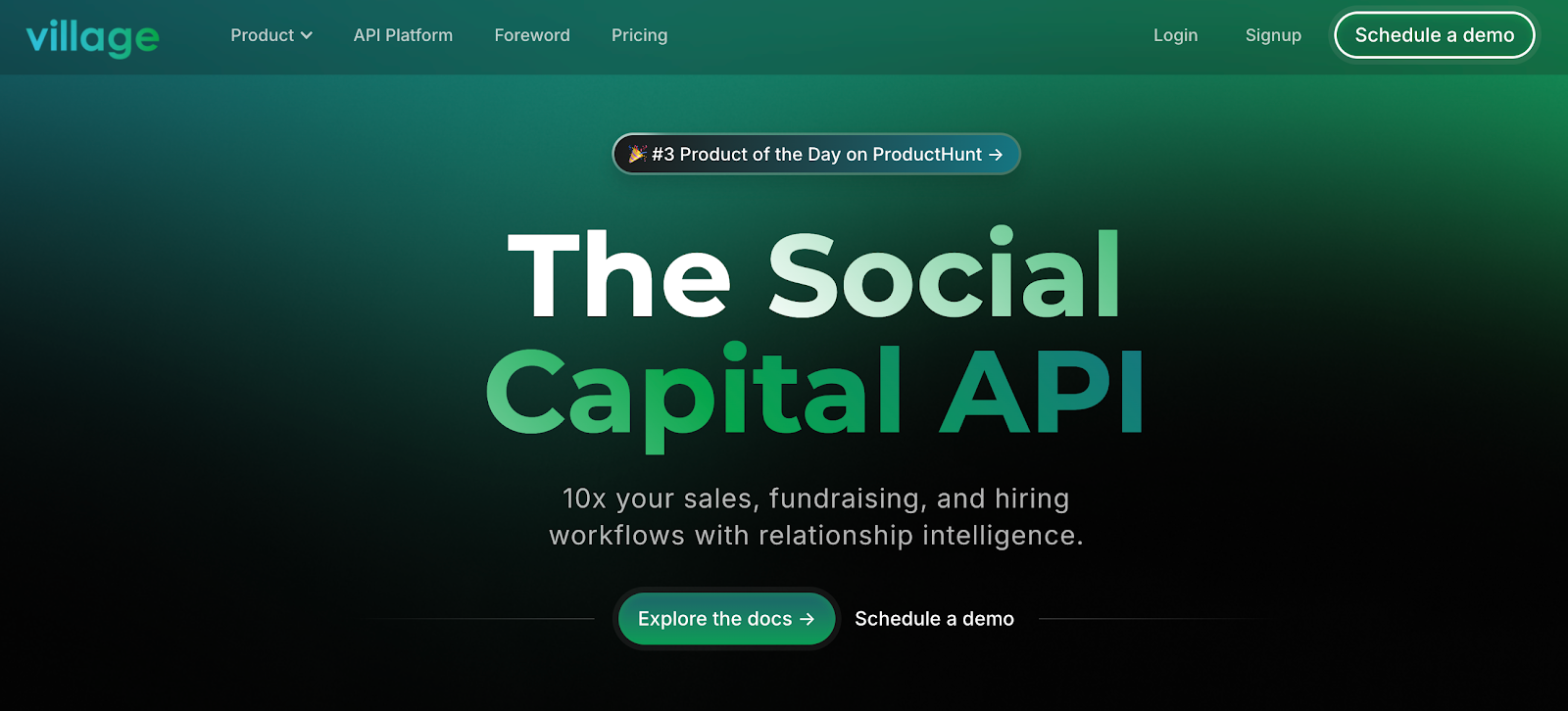Finding investors is rarely simple. Most founders end up chasing cold leads, sending dozens of emails, and hoping someone responds. That approach wastes time and rarely moves your business forward.
You don’t need a long list of names. You need aligned contacts who invest in your industry, at your stage, and with a clear interest in what you’re building.
In this guide, you’ll learn how to find investors who match your goals. You’ll see where to look, how to qualify potential investors, and the most effective ways to start a conversation that guarantees funding.
What Makes an Investor a Good Fit for Your Business?
Some investors aren't aligned with what you're building. They might invest in different industries, prefer late-stage deals, or expect involvement you're not ready for. Just because someone has capital doesn’t mean they’re the person you want involved.
You’re not only raising money. You’re building relationships that affect how your business grows. That starts with knowing who supports the kind of work you’re doing and how involved they’ll be.
Strategic or Financial Investors: What’s the Difference?
Some investors bring more than a check. They know your space, offer advice based on experience, and introduce you to people who can help. These tend to be former founders, operators, or partners at venture capital firms.
Others prefer to invest quietly. These might be private individuals, family members, or people you meet through referrals. They provide support without needing updates or a seat at the table.
Think about whether you:
- Want someone involved in decisions
- Need help finding talent, partners, or customers
- Would rather manage the business without extra input
Getting clear on this will help you avoid frustration later on.
What Investors Usually Look For
You don’t need a perfect pitch or a polished story. What you do need is clarity. Investors want to know what you're building, why it matters, and whether you're the person to make it happen.
Most investors are looking for a business plan with focus and direction, a team that knows the space, and interest from real customers or signs that people want the product.
Whether you're meeting with angel investors, venture capitalists, or private investors, the goal is the same. Show that you’ve thought it through, know what you need, and are ready to move forward.
How Do You Find Investors That Match Your Business?
Each investor comes with different associated risks, depending on how they invest and what they expect in return.
Here are some tips on how to find the people who are more likely to take an interest in your business.
Find Angel Investors for Early Stage Startups
If you're just getting started, angel investors are often the most accessible place to begin. They usually support early-stage startups and can be more flexible than larger firms.
Some are individual investors looking to support founders with strong ideas, while others are part of formal networks that share industry knowledge and collaborate on deals.
To find them, you should:
- Ask local entrepreneurs who funded their first round
- Look into an angel investment network in your region or industry
- Join pitch events or demo days that attract early backers
- Talk to a financial advisor who works with investors open to private deals
These early supporters often bet on business owners, not just numbers. They want to see your vision, hear how you think, and know you’re serious about putting in the work.
Find Venture Capital Firms by Sector
Once you have some traction, it may be time to approach venture capital firms. These firms usually specialize by industry and stage. Some back only seed rounds. Others write checks for growth-stage companies.
To focus your search, look at other startups in your space and who funded them. You should also ask your existing network if anyone has connections to the firms on your list.
These investors usually want a strong team, a big market, and a product that already has some momentum. They also want to know how much funding you’re looking for and what you plan to do with it.
Explore Real Estate and Other Sectors
If you're a real estate agent or manage properties, you may be looking for real estate investors, not venture capital. In that case, your strategy will look different.
To find real estate investors:
- Attend local real estate meetups or investment groups
- Talk to brokers who work with private investors
- Explore forums where people discuss real estate investing
These investors often focus on cash flow, property value, and risk profile. They’re less interested in a pitch deck and more interested in your numbers.
If your business doesn’t fit the equity model, a traditional business loan or crowdfunding campaign may make sense as an alternative funding option.
What Is the Best Way to Reach Out to Investors?
Once you know who you’re targeting, how you reach out matters. Most investors get a steady stream of messages. If yours feels generic, it’s probably getting skipped.
Your message doesn’t have to be long. It just needs to be personal, relevant, and clearly show why you’re reaching out.
Cold Emails or Warm Introductions
Cold emails can work, but they’re a numbers game. Unless you already have traction or a sharp hook, it’s easy to get ignored.
Warm intros cut through that noise. When someone trusted passes along your name, people pay more attention. It’s direct, respectful, and far more likely to lead to a conversation.
If warm intros are part of your strategy, Village helps you do it better. It maps your network, highlights real connections, and shows who can introduce you to an investor. You get a ranked list of intro paths, plus ready-to-send request drafts that are based on past interactions and mutual context.
Ways to get warm intros:
- Ask previous investors if they know anyone aligned with your space
- Reach out to founders who’ve raised funding from the firms you’re targeting
- Use Village to see which of your contacts already have a trusted link
You don’t need to chase 200 emails. You just need a few well-placed introductions.
How to Ask for an Introduction Without Making It Awkward
People are more likely to help if you make it easy for them to forward your message. Give them the context, keep it short, and let them know you’re open to a double opt-in. That way, they’re not caught off guard, and no one feels pressured.
Make it easier by including:
- A short sentence about your business
- Why you’re reaching out now
- A link to your pitch deck if it’s ready
- A clear request, like “Would you be open to introducing us?”
Being low-pressure makes it easier for someone to help you.
If You’re Reaching Out Directly
Get straight to the point. Say who you are, what you're building, and why you’re reaching out. Mention if you saw a portfolio company that overlaps with your space or if they’ve backed similar teams.
Avoid vague phrases. Don’t say “we’re building something disruptive” or “we’re solving a huge problem.” Say what your product does, who it’s for, and why you think it’s worth attention now.
Tools That Can Help You Find and Track Investors
Finding investors is one part research and one part outreach. But it’s easy to lose track of who you’ve contacted or what stage a conversation is in.
If you’re doing research, these tools can help you see who’s funding companies like yours:
- Crunchbase: Find out which investors backed similar startups
- AngelList: Discover angel investors and early-stage backers
- PitchBook: Deeper insights for those working with institutional investors
- LinkedIn: Spot mutual contacts or shared connections
These tools are good for research, but they don’t help you figure out how to reach out or who can introduce you.
Use Village to Get Warm Introductions
Village goes further than a database. It shows you who in your network can connect you to venture capital firms, private investors, or angel networks. Then it helps you ask for those intros the right way.
Here’s what makes it different:
- Syncs with your inbox, calendar, and LinkedIn
- Finds real interactions, not just who you're connected to
- Ranks potential intro paths based on trust and past activity
- Gives you ready-to-send intro request drafts
- Tracks your outreach in one place from request to meeting
Other tools give you lists. Village gives you a clear path to prospective investors based on who you already know.
Mistakes That Slow Down Your Investor Outreach
Most founders run into the same roadblocks when trying to raise capital. Some waste time reaching out to the wrong people. Others send rushed emails without research, or wait too long to start building relationships.
Below are some common mistakes you'll want to avoid:
Reaching Out to Investors Who Don’t Align With Your Business
Not everyone you find through online platforms or referral lists will be the right investor. Some venture capitalists focus only on late-stage companies. Others invest only in specific industries or avoid solo founders. If you don’t check for alignment first, you risk spending weeks in conversations that go nowhere.
Before you reach out, look at who they’ve backed. See if they’ve worked with early-stage startups in your space. Make sure your business plan fits the type of investments they make.
Sending Generic Messages Without Research
You don’t need a perfect pitch, but you do need to show that you’ve done your homework. When prospective investors get the same message someone else received, it’s clear you're guessing.
A better approach is to start with something specific. Mention a company they’ve supported or a market they understand. Explain why you’re reaching out now and how your company lines up with their focus. A thoughtful message often leads to a response, even if the timing isn’t perfect.
Delaying Relationship Building Until You’re Raising Money
Waiting until you’re running low on money can back you into a corner. Fundraising takes time. You need more than one meeting to build trust, especially with angel investors and venture capital firms who like to track founders before they invest.
Start early. Share occasional updates, even if you’re not raising yet. It helps people see your momentum and makes it easier to re-engage when you're ready to raise capital.
Find the Right Investors Faster With Village

Finding investors isn’t about sending more emails. It’s about getting in front of people who trust you or trust the person introducing you. That’s what Village helps you do.
Village helps you raise capital by turning your existing network into a source of warm, targeted introductions. It syncs with your Gmail, calendar, and LinkedIn to analyze emails, meetings, shared deals, and shows you who can introduce you to an investor, how strong that relationship is, and when to reach out.
You’ll get:
- Ranked intro paths to angel investors, venture capital firms, and private investors
- AI-generated intro requests based on actual history with shared contacts
- Visibility into each intro’s status, from request to meeting booked
- Support for double opt-in to protect relationships and keep intros high-trust
- Embedded tools that work inside your CRM or as a standalone widget
Whether you're raising your first round or managing investor outreach across multiple deals, Village gives you the visibility, context, and timing you need to move fast and raise smarter.
Want to reach investors without cold pitching hundreds of people? Try Village for free or schedule a demo now!
FAQs About How to Find Investors
How do you go about finding an investor?
Start by identifying who invests in your type of business, at your stage, and in your industry. Focus on building relationships through referrals or tools like Village that reveal trusted paths to both investors and potential partners. For small businesses, angel networks and crowdfunding platforms are also worth exploring.
How can I find someone to invest in me?
Begin with people who know your work and understand your market. Warm introductions from shared contacts are far more effective than cold outreach. Whether it’s one partner at a venture fund or a pension fund interested in innovation, people are more likely to engage when your business model is relevant and trust is already in place.
How much do you pay an investor?
You don’t pay them directly. Investors provide capital in exchange for equity. That means they own a percentage of your company. Always go through due diligence to avoid costly mistakes and make sure any ownership you give up aligns with your long-term goals.
Is there a website to find investors?
Yes. You can search for many investors through Crunchbase, AngelList, or similar online platforms. These are great for research, but they don’t show you who can introduce you. Village helps by mapping your real network and revealing who can help you reach investors through personal, trusted connections.










